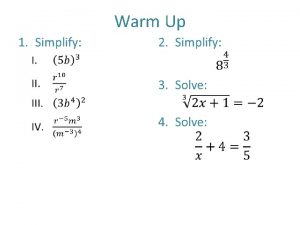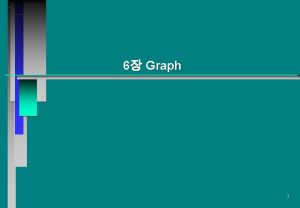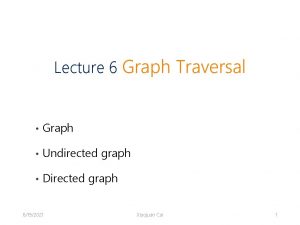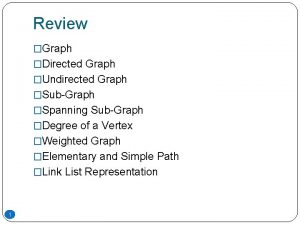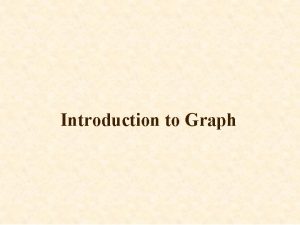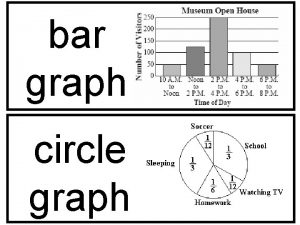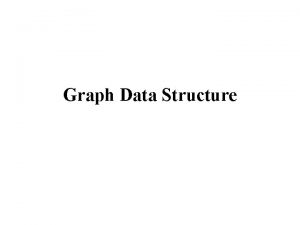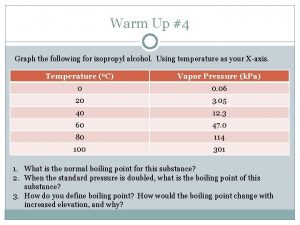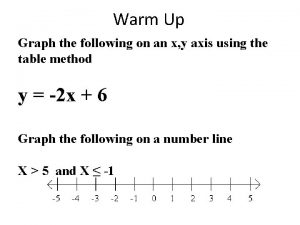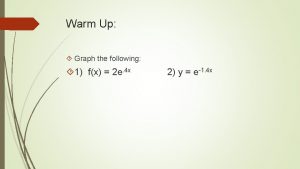Warm Up Graph the following 1 fx 2



















- Slides: 19

Warm Up: Graph the following: 1) f(x) = 2 e. 4 x 2) y = e-1. 4 x

6. 3 Notes: Log basics

Exponential Functions: Exponential functions have the variable located in the exponent spot of an equation/function. EX: 2 x = 6 32 x-7 = 98 72 x = 54

So, what is a logarithm? Well, if we were given 2 x = 4, we could figure out that x is 2. If we were given 3 x = 27, we could figure out that x = 3. But what about 2 x = 6? Do we know what power 2 is raised to to make 6? How do we solve this then? Well, just like we would solve any other equation (3 x + 7 = 19), we use OPPOSITE OPERATIONS. The opposite of an exponent is a logarithm

Logarithmic form: The log form is: logby = x Translating between forms: Exponential form: Logarithmic form: bx = y logby = x “b” is the base “x” is the exponent “y” is the “answer”

Examples: Change into log form: A) 3 x = 9 B) 7 x = 343 C) 5 x = 625 Change into exponential form: D) log 6 a = 2 E) log 416 = y F) log 327 = t

Common and Natural Logs The only difference between common logs and natural logs is the base. The common log has a base of 10. Just like ones, the base of 10 is not written and understood. Log 10 x = log x The natural log has a base of “e. ” It is not written and understood to be the base. Logex = ln x

Can we find these answers in the calculator? ABSOLUTELY! The calculator recognizes only base 10 and base e logarithms. Let’s find the buttons…. . EX: log 8 ln 0. 3 log 15 ln 5. 72 What do these mean? What are they asking?

HW: p. 314 #5 – 16, 27 - 32

Warm Up:

Inverse properties: Inverse properties are opposites, they “un-do” each other’s operation. A) logbbx = x B) =x EX: log 774 = = EX: log 11116 = = EX: log 525 x =

Finding Inverse Functions: Remember, when we found inverse functions before break, we did the following steps: A) Swap the x and y B) solve for y using inverse (opposite) operations C) Simplify the answer if necessary EX: 1) f(x) = 6 x 3) h(x) = ex 2) y = ln(x + 3) 4) y = log(x + 6)

Exponential Graph Transformations: Describe (in words) the transformation(s), sketch the graph and give the domain and range: 1) g(x) = ex+4 + 2 2) y = -(½)x - 3

Graphing Log Functions (by hand)

Log Graph Basics: Because the equations of logarithms are inverses (opposites) of exponential equations, the basics of the graphs are also inverses (opposites). “Go – to” point is (1, 0) Vertical asymptote at x = 0 To graph by hand, rewrite the log into an exponential equation, make a table of values, then use the inverse of the table (swap the x and y values) to graph the log function.

Examples: (don’t forget to give the D & R!) 1) f(x) = log 3 x 2) g(x) = log½x

Graph: h(x) = log 5 x a(x) = log ¾ x

p. 315 #35 -42, 55 -59

Warm Up: Rewrite
 Hình ảnh bộ gõ cơ thể búng tay
Hình ảnh bộ gõ cơ thể búng tay Ng-html
Ng-html Bổ thể
Bổ thể Tỉ lệ cơ thể trẻ em
Tỉ lệ cơ thể trẻ em Gấu đi như thế nào
Gấu đi như thế nào Chụp phim tư thế worms-breton
Chụp phim tư thế worms-breton Hát lên người ơi
Hát lên người ơi Môn thể thao bắt đầu bằng từ chạy
Môn thể thao bắt đầu bằng từ chạy Thế nào là hệ số cao nhất
Thế nào là hệ số cao nhất Các châu lục và đại dương trên thế giới
Các châu lục và đại dương trên thế giới Công thức tính thế năng
Công thức tính thế năng Trời xanh đây là của chúng ta thể thơ
Trời xanh đây là của chúng ta thể thơ Mật thư anh em như thể tay chân
Mật thư anh em như thể tay chân Phép trừ bù
Phép trừ bù độ dài liên kết
độ dài liên kết Các châu lục và đại dương trên thế giới
Các châu lục và đại dương trên thế giới Thơ thất ngôn tứ tuyệt đường luật
Thơ thất ngôn tứ tuyệt đường luật Quá trình desamine hóa có thể tạo ra
Quá trình desamine hóa có thể tạo ra Một số thể thơ truyền thống
Một số thể thơ truyền thống Cái miệng bé xinh thế chỉ nói điều hay thôi
Cái miệng bé xinh thế chỉ nói điều hay thôi






















